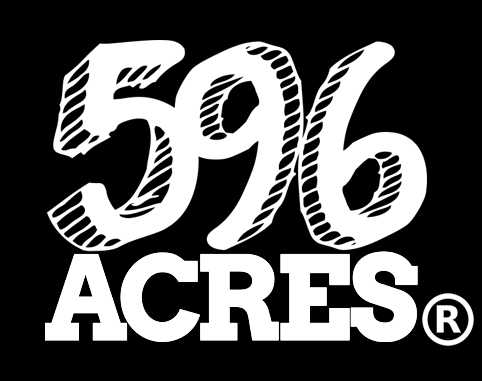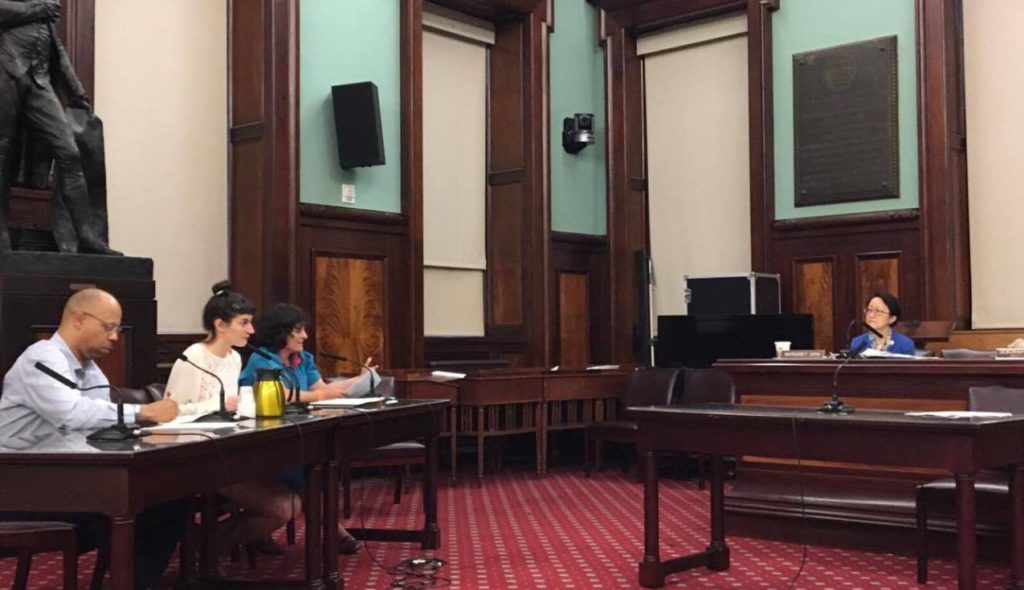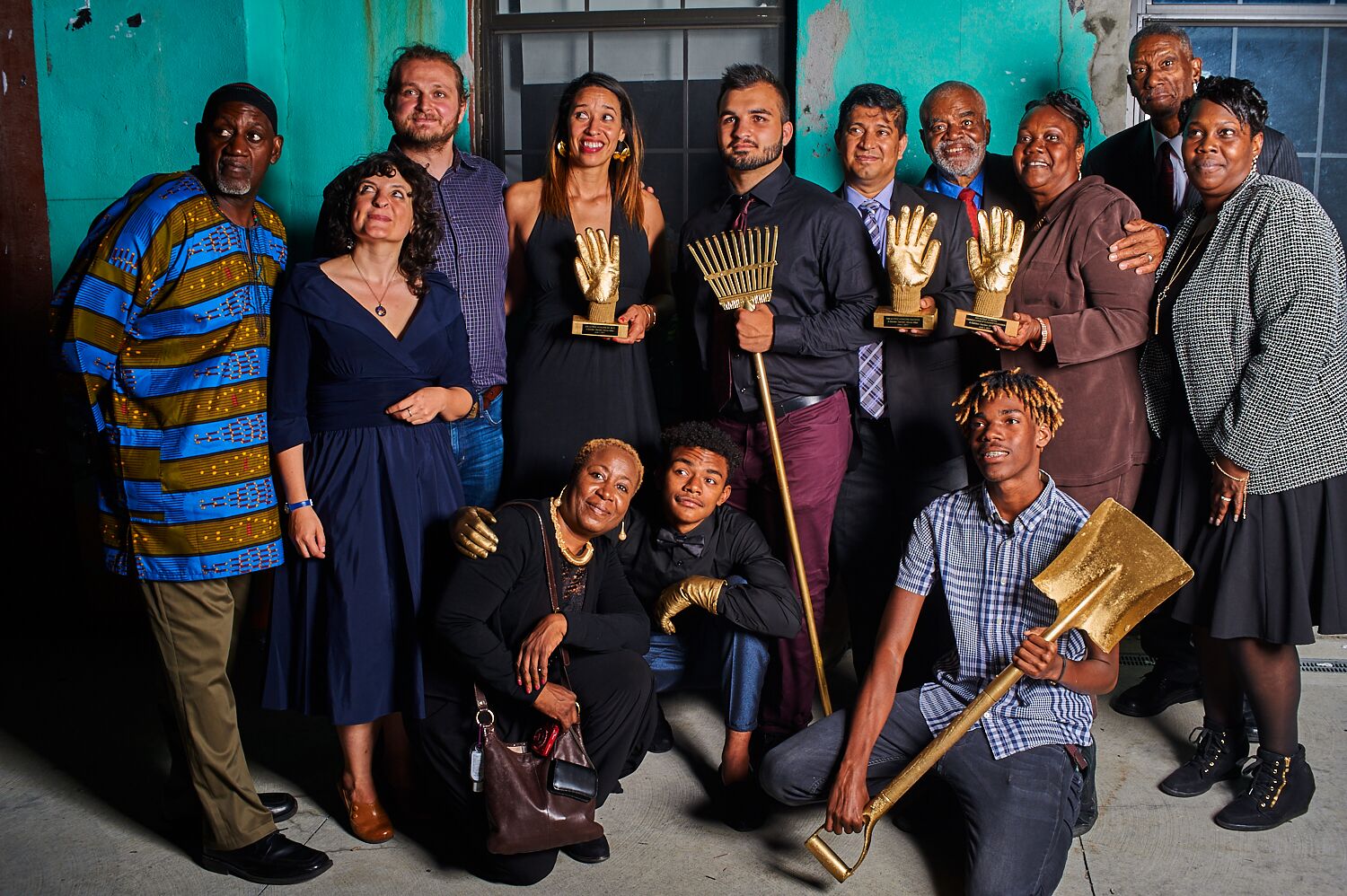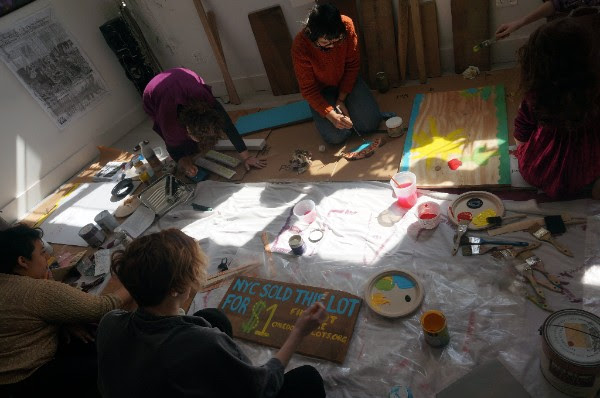Urban Renewal Area planning has left acres of abandoned city-owned lots in NYC’s neighborhoods that had already suffered decades of disinvestment caused by legally-instituted racism. We have long been holding the city accountable to its abandoned Urban Renewal Area Plans via our tool urbanreviewer.org. Now the City is making moves to hold itself accountable!
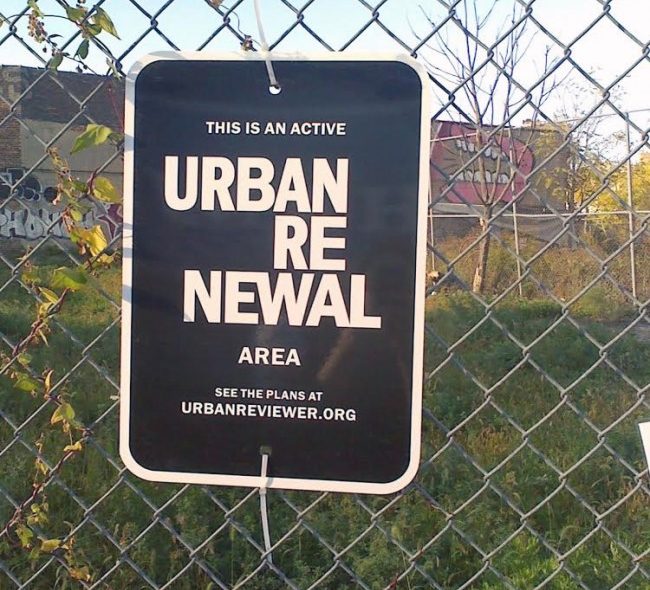 On Thursday, June 15 at 2pm (City Hall’s Council Chambers), Mara Kravitz of 596 Acres and Paula Z. Segal of the Equitable Neighborhoods Practice of the Community Development Project at the Urban Justice Center (and our founding director!) testified to City Council about Intro 1533-2017. This potential legislation, introduced by NYC Council Members Margaret S. Chin and Antonio Reynoso, builds on 596 Acres’ Urban Reviewer project by requiring our City government keep its own publicly accessible online database of Urban Renewal Area plans.
On Thursday, June 15 at 2pm (City Hall’s Council Chambers), Mara Kravitz of 596 Acres and Paula Z. Segal of the Equitable Neighborhoods Practice of the Community Development Project at the Urban Justice Center (and our founding director!) testified to City Council about Intro 1533-2017. This potential legislation, introduced by NYC Council Members Margaret S. Chin and Antonio Reynoso, builds on 596 Acres’ Urban Reviewer project by requiring our City government keep its own publicly accessible online database of Urban Renewal Area plans.
Watch City Council’s video of our testimonies along with Trevor Holland on behalf of CAAAV Organizing Asian Communities and Good Old Lower East Side (GOLES)! Paula of Equitable Neighborhoods goes on at 1:40:37, Mara of 596 Acres at 1:45:50 and Trevor on behalf of CAAAV and GOLES at 1:49:30. Read Paula and Mara’s written testimonies below.
* * *

Mara Dawn Kravitz
Director of Partnerships
540 President Street #2E
Brooklyn, NY 11215
(718) 316-6092 Ext. 3
mara@596acres.org
June 15, 2017
Good afternoon. My name is Mara Kravitz and I am the director of partnerships at 596 Acres, New York City’s Community Land Access Advocacy Organization. 596 Acres champions resident stewardship of land to build more just and equitable cities.
Thank you so much to the Committee for holding this hearing today and to Council Members Reynoso and Chin for introducing this bill to ensure that the most impacted New Yorkers have access to information about how Urban Renewal Area Plans are currently affecting their neighborhoods, and how these plans will continue to shape communities going forward.
596 Acres works with grassroots organizers who create campaigns in their neighborhoods to transform abandoned lots — mostly city-owned — into community resources like gardens, parks, farms, community centers, sustainability hubs, and more. This has led to the creation of more than 40 community-managed public spaces citywide where vacant lots used to be.
Urban Renewal Area planning has left acres of abandoned city-owned lots in NYC’s neighborhoods, areas that had already suffered decades of disinvestment as a result of legally-instituted racism, mapped out on the Homeowner’s Loan Corporation’s infamous redline maps. Many local campaigns we have supported are therefore in direct conversation with Urban Renewal Area history. Where active plans to create Open Space, for example, were abandoned, grassroots organizers have brought them to life through local planning and advocacy. By being able to reference the specific policies that have led to their experiences of neglect of their neighborhoods, organizers are able to work together to transform more than just vacant city-owned land, but deleterious historical practices of top-down development that have disenfranchised and disempowered the most impacted people from being able to participate in essential decisions affecting all levels of their livelihoods.
We are able to connect organizers with accurate information about Urban Renewal Area plans because of research 596 Acres did in 2014, culminating in UrbanReviewer.org. Realizing no such reference tool for Urban Renewal Area plans existed, and knowing how valuable it would be for our organizers in our citywide network to have information about what promises the city made for so many of today’s vacant city-owned lots, we engaged Housing Preservation and Development (HPD) via the Freedom of Information Law (FOIL) to get access to all the plans, sent a small army of researchers to their offices to read each and every one, and put information about sites gleaned from them online — for the first time ever — at urbanreviewer.org.
This website, which has information about each lot in the plan and what promises the city made for it when it was condemned and cleared, supports my work as an advocate, along with those of my colleagues and the hundreds of grassroots advocates making change in their neighborhoods citywide. Our site is up to date now, but there is no mechanism in place to update it as new plansare adopted and old ones expire. This is because there is no centralized place where information is regularly published and updated. This bill, once it becomes law, will happily change that and fill a huge gap in public knowledge about key information about the future of the City!
To make it an effective reference tool, this bill must be amended so that the database is useful to those most impacted by Urban Renewal Area planning (that is, people living in or near Urban Renewal Areas, present and past). With accurate information and a vision of what’s possible, these people are best poised to lead and sustain the development of their neighborhoods towards a more just and resilient NYC. To that end, 596 Acres recommends the following changes be made to the bill.
First, instead of simply announcing imminent plan expirations as the current draft of the bill requires, the legislation should be revised to require annual reporting on all active urban renewal plans that includes their expiration dates as well as other key details for properties included in each plan, which I will outline shortly. Legislation should require reports to be produced by borough, council district and community district and delivered to Borough Presidents (BPs), Council Members (CMs), and Community Boards (CBs) for their jurisdictions by a specific date each year.
In addition to producing these annual status updates, the HPD, New York City’s Urban Renewal Agency, should be directed to publish every adopted plan, as adopted, and every revision adopted in its full form on a NYC website accessible to the public. Ideally, these digitized documents would be linked to a user-friendly map interface so that New Yorkers can access plans for their neighborhoods by searching for their address or ZIP code. I encourage you to visit urbanreviewer.org as a pilot version of such a mapping tool.
Annual urban renewal status reports encompassing all properties in active Urban Renewal Areas should be done by Borough Block and Lot number and include the following:
- Specific planned uses of all properties
- Current uses of all properties in active Urban Renewal Areas (URAs)
- All planned acquisitions by the City or any other public authority
- All completed acquisitions
- All planned dispositions, including the name of entity to which each lot would be disposed, the price proposed to be paid, and any restrictive covenants, deed restrictions or other terms set at the time of disposition, and what public review of the disposition is required (e.g. through ULURP or the accelerated Urban Development Action Area Program, which allows the City to avoid full public review for dispositions of public land in URAs)
- Completed dispositions, including the name of entity to which each lot was disposed, the price paid, and any restrictive covenants, deed restrictions or other terms set at the time of disposition, and what public review of the disposition was completed
- Status of any planned, in process or completed relocation of tenants from properties in the plan area
Thank you so much for accepting my testimony today. I look forward to working together in the decades to come for a more just and participatory city.
* * *

June 15, 2015
Good afternoon. My name is Paula Segal. I am speaking today as an Attorney in the Equitable Neighborhoods Unit of the Community Development Project (CDP) at the Urban Justice Center. CDP works with grassroots groups, neighborhood organizations and community coalitions to help make sure that people of color, immigrants, and other low-income residents who have built our city are not pushed out in the name of “progress.” We work together with our partners and clients to ensure that residents in historically under-resourced areas have stable housing they can afford, places where they can connect and organize, jobs to make a good living, and other opportunities that allow people to thrive.
Thank you to the Committee for holding this hearing today and to Council Members Reynoso and Chin for introducing this bill which will ensure that New Yorkers have access to information about how Urban Renewal Area Plans are currently impacting their neighborhoods and what impacts are planned.
Urban Renewal Area Plans have been adopted for New York City neighborhoods since 1949, giving the City the power to condemn private properties for the public good of eliminating “blight” and making room for new development. The federal government created the program to aid cities in replacing neighborhoods deemed substandard after World War II with superblocks and towers in the park that were to be the hallmarks of the “modern” American City. Designating an area as an Urban Renewal Area takes a simple finding of substandard conditions, with no standard definition driving them. Once an area is so designated, eminent domain can be used to transfer properties within the district to the City without any further question of whether such transfer serves a public purpose. Urban Renewal Area Plans were used in the latter part of the twentieth century to make way for cooperative private housing created through the Mitchell Lama program and public housing built by NYCHA, the City and the State.
Urban Renewal was called “Negro Removal” by James Baldwin, reflecting the stark reality that in New York City alone, between 1949 and 1974, it led to the displacement of 100,000 African American residents from their neighborhoods, and displaced very few other people. Before 1974, the federal government provided funding for government acquisition and demolition of buildings in urban renewal areas. In 1974, admitting that urban renewal led to segregation and devastation in American cities, the federal government stopped funding it.
But New York City continued to use Urban Renewal Plans without federal support. Of the 64 active urban renewal plan areas with us today, 55 were adopted after federal funding was cut off. A new Urban Renewal Plan Area is currently going through the ULURP process right now, designed to designation Downtown Far Rockaway an Urban Renewal Area to facilitate the government taking of a privately-owned strip mall and other properties to facilitate their transfer to developers of apartment buildings. Aldo in Rockaway, the Edgemere Urban Renewal Area Plan is scheduled to be revised in 2019.
Urban Renewal Plans often include planned uses for properties in the plans, and many of these uses are oriented towards true public purposes: parks, open space, schools, community centers, and of course, affordable housing. Community input into planning for the Edgemere revision led to HPD’s commitment to include the creation of a community land trust to keep housing affordable in the revised plan and the creation of waterfront access along the entire edge of the peninsula facing the bay.
The plans themselves frequently serve as time-keepers for public-serving land use instruments impacting properties in the Plan Areas. For example, deed restrictions obligating Mitchell Lama cooperatives to follow affordability restrictions in reselling shares were written to expire at the expiration of the Urban Renewal Plans that facilitated their site acquisitions. Urban Renewal Plans typically last 40 years; the drafters of such restrictions may have thought it was a very long time. But as we have seen with South Bridge Towers and other restricted cooperative developments that have elected to sell to the unregulated market, it actually sneaks up quite fast.
Even faster if there is no mechanism for the public and our elected advocates to keep track of promises made and plan expiration dates.
Before my current role, I was the founding director of 596 Acres,[1] NYC’s community land access advocacy organization. Recognizing that many of today’s vacant publicly owned lots are in our public trust because they are the products of incomplete urban renewal plans, we sought information about those plans and what promises they made for today’s vacant lots in 2014. Realizing that there was simply nowhere to find this information, we engaged Housing Preservation and Development (HPD) via the Freedom of Information Law to get access to the plans, sent a small army of researchers to their offices to read each one and put information about sites included in them online for the first time ever at urbanreviewer.org. That website is a resource to me in my work now and to hundreds of organizers and advocates, some in City Hall, who routinely provide feedback about its utility to their work. The site is up to date now, but there is no mechanism to update it as new plans are adopted and old ones expire because there is no place where information is regularly published. This bill, once it becomes law, will happily change that and fill a huge gap in public knowledge about key information about the future of the City.
To do so effectively, the bill must be amended to reflect the realities of community organizing, the structure of the plans and their execution and best practices in information delivery to New Yorkers.
Instead of simply announcing imminent plan expirations as the current draft of the bill requires, the legislation should be revised to require annual reporting on all active urban renewal plans that includes their expiration dates as well as other key details for properties included in each plan, which I will outline shortly. Legislation should require reports to be produced by borough, council district and community district and delivered to BPs, CMs and CBs for their jurisdictions by a specific date each year.
In addition to producing these annual status updates, the HPD, New York City’s Urban Renewal Agency, should be directed to publish every adopted plan, as adopted, and every revision adopted in its full form on a NYC website accessible to the public. Ideally these digitized documents would be linked to a map interface so that New Yorkers can access plans for their neighborhoods by searching for their address or zip code. I encourage you to look at urbanreviewer.org as a pilot version of such a mapping tool.
Annual urban renewal status reports encompassing all properties in active Urban Renewal Areas should be done by Borough Block and Lot number and include the following:
- Specific planned uses of all properties
- Current uses of all properties in active Urban Renewal Areas (URAs)
- All planned acquisitions by the City or any other public authority
- All completed acquisitions
- All planned dispositions, including the name of entity to which each lot would be disposed, the price proposed to be paid, and any restrictive covenants, deed restrictions or other terms set at the time of disposition, and what public review of the disposition is required (e.g. through ULURP or the accelerated Urban Development Action Area Program, which allows the City to avoid full public review for dispositions of public land in URAs)
- Completed dispositions, including the name of entity to which each lot was disposed, the price paid, and any restrictive covenants, deed restrictions or other terms set at the time of disposition, and what public review of the disposition was completed
- Status of any planned, in process or completed relocation of tenants from properties in the plan area
Thank you so much for accepting my testimony today. I look forward to working together in the coming months to improve the bill and in the decades to come for a more just and participatory city.
[1] I would also encourage HPD to post status updates directly on the fences of vacant properties included in Urban Renewal Plans.
